Addressing Aviation Manager Shortfall in the UAE Aviation Industry
VerifiedAdded on 2023/06/11
|12
|2956
|140
Essay
AI Summary
This essay addresses the significant shortfall of aviation managers in the United Arab Emirates' aviation business. It proposes a comprehensive model to solve this problem over the next five years, focusing on analyzing current requirements, sourcing licensed managers, providing management training, and implementing effective employee attraction and retention strategies. The essay emphasizes the importance of understanding departmental needs, advertising vacancies, and offering competitive incentives. It also highlights the value of management training aligned with FAA guidelines, workforce flexibility, and supplemental staffing through internship programs. Furthermore, the essay explores various methods of employee retention, including establishing duty guidelines, providing incentives, and fostering a total reward approach. The goal is to ensure a sufficient number of qualified aviation managers to maintain smooth, safe, and efficient operations within the aviation industry. The essay concludes by suggesting alternative methods to create its own managers to curb the shortfall.
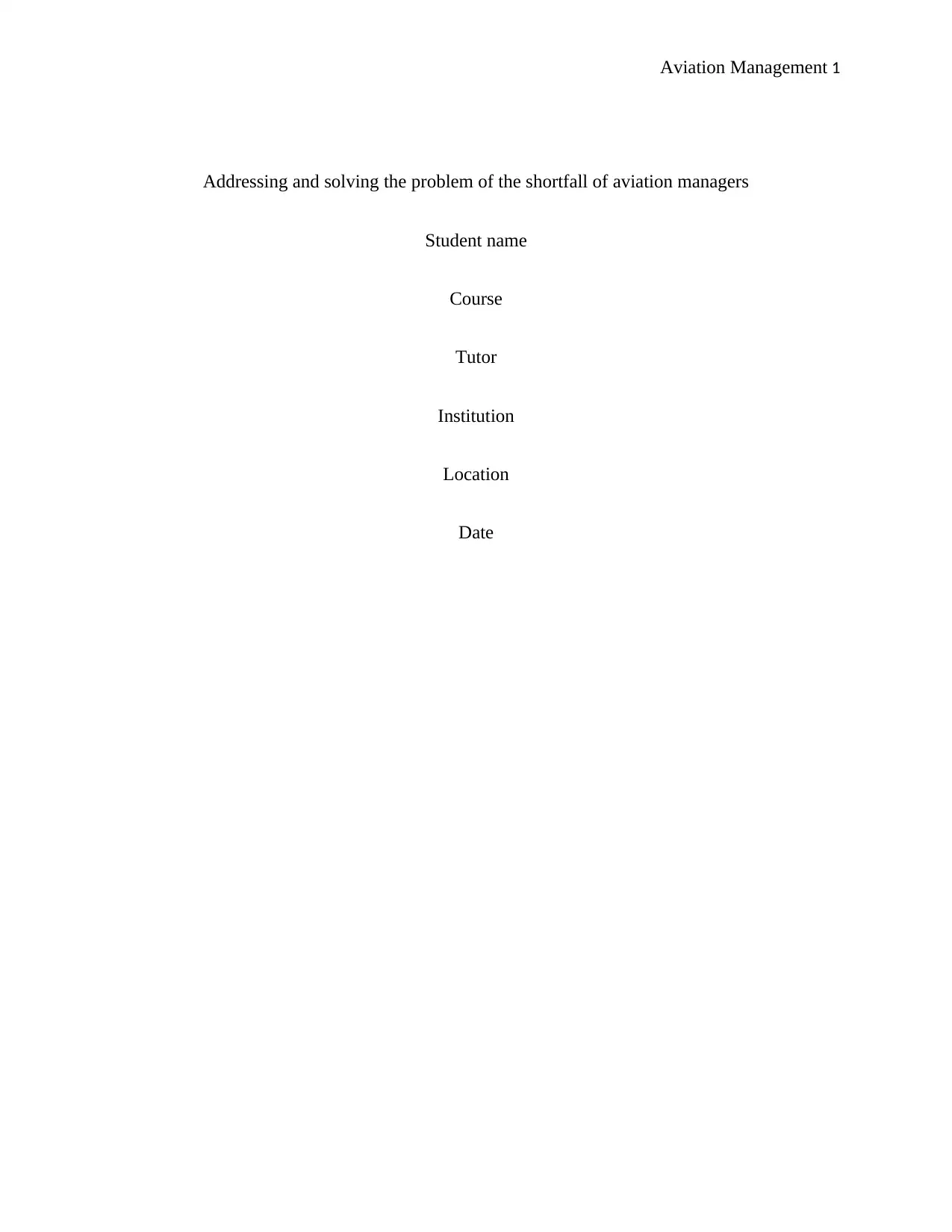
Aviation Management 1
Addressing and solving the problem of the shortfall of aviation managers
Student name
Course
Tutor
Institution
Location
Date
Addressing and solving the problem of the shortfall of aviation managers
Student name
Course
Tutor
Institution
Location
Date
Paraphrase This Document
Need a fresh take? Get an instant paraphrase of this document with our AI Paraphraser
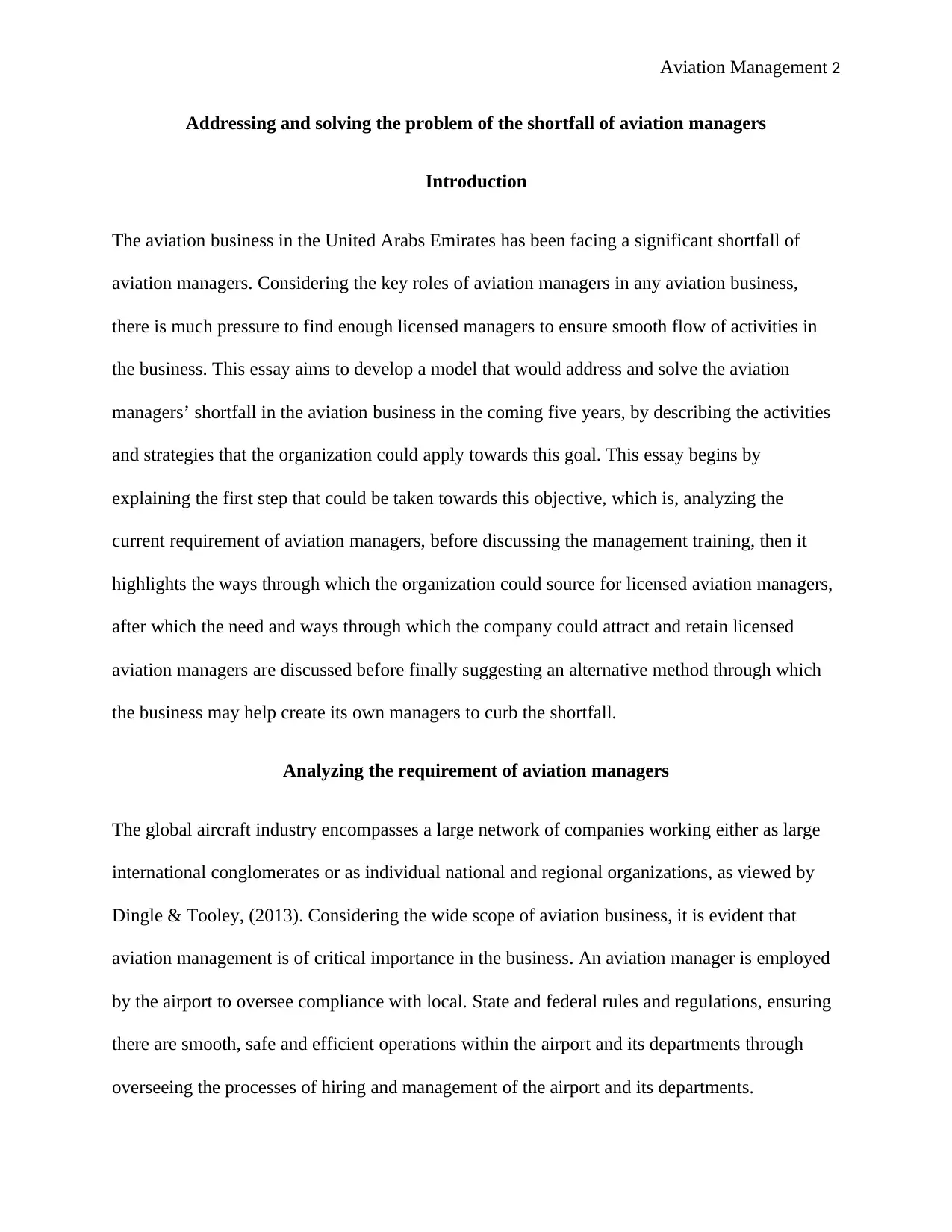
Aviation Management 2
Addressing and solving the problem of the shortfall of aviation managers
Introduction
The aviation business in the United Arabs Emirates has been facing a significant shortfall of
aviation managers. Considering the key roles of aviation managers in any aviation business,
there is much pressure to find enough licensed managers to ensure smooth flow of activities in
the business. This essay aims to develop a model that would address and solve the aviation
managers’ shortfall in the aviation business in the coming five years, by describing the activities
and strategies that the organization could apply towards this goal. This essay begins by
explaining the first step that could be taken towards this objective, which is, analyzing the
current requirement of aviation managers, before discussing the management training, then it
highlights the ways through which the organization could source for licensed aviation managers,
after which the need and ways through which the company could attract and retain licensed
aviation managers are discussed before finally suggesting an alternative method through which
the business may help create its own managers to curb the shortfall.
Analyzing the requirement of aviation managers
The global aircraft industry encompasses a large network of companies working either as large
international conglomerates or as individual national and regional organizations, as viewed by
Dingle & Tooley, (2013). Considering the wide scope of aviation business, it is evident that
aviation management is of critical importance in the business. An aviation manager is employed
by the airport to oversee compliance with local. State and federal rules and regulations, ensuring
there are smooth, safe and efficient operations within the airport and its departments through
overseeing the processes of hiring and management of the airport and its departments.
Addressing and solving the problem of the shortfall of aviation managers
Introduction
The aviation business in the United Arabs Emirates has been facing a significant shortfall of
aviation managers. Considering the key roles of aviation managers in any aviation business,
there is much pressure to find enough licensed managers to ensure smooth flow of activities in
the business. This essay aims to develop a model that would address and solve the aviation
managers’ shortfall in the aviation business in the coming five years, by describing the activities
and strategies that the organization could apply towards this goal. This essay begins by
explaining the first step that could be taken towards this objective, which is, analyzing the
current requirement of aviation managers, before discussing the management training, then it
highlights the ways through which the organization could source for licensed aviation managers,
after which the need and ways through which the company could attract and retain licensed
aviation managers are discussed before finally suggesting an alternative method through which
the business may help create its own managers to curb the shortfall.
Analyzing the requirement of aviation managers
The global aircraft industry encompasses a large network of companies working either as large
international conglomerates or as individual national and regional organizations, as viewed by
Dingle & Tooley, (2013). Considering the wide scope of aviation business, it is evident that
aviation management is of critical importance in the business. An aviation manager is employed
by the airport to oversee compliance with local. State and federal rules and regulations, ensuring
there are smooth, safe and efficient operations within the airport and its departments through
overseeing the processes of hiring and management of the airport and its departments.
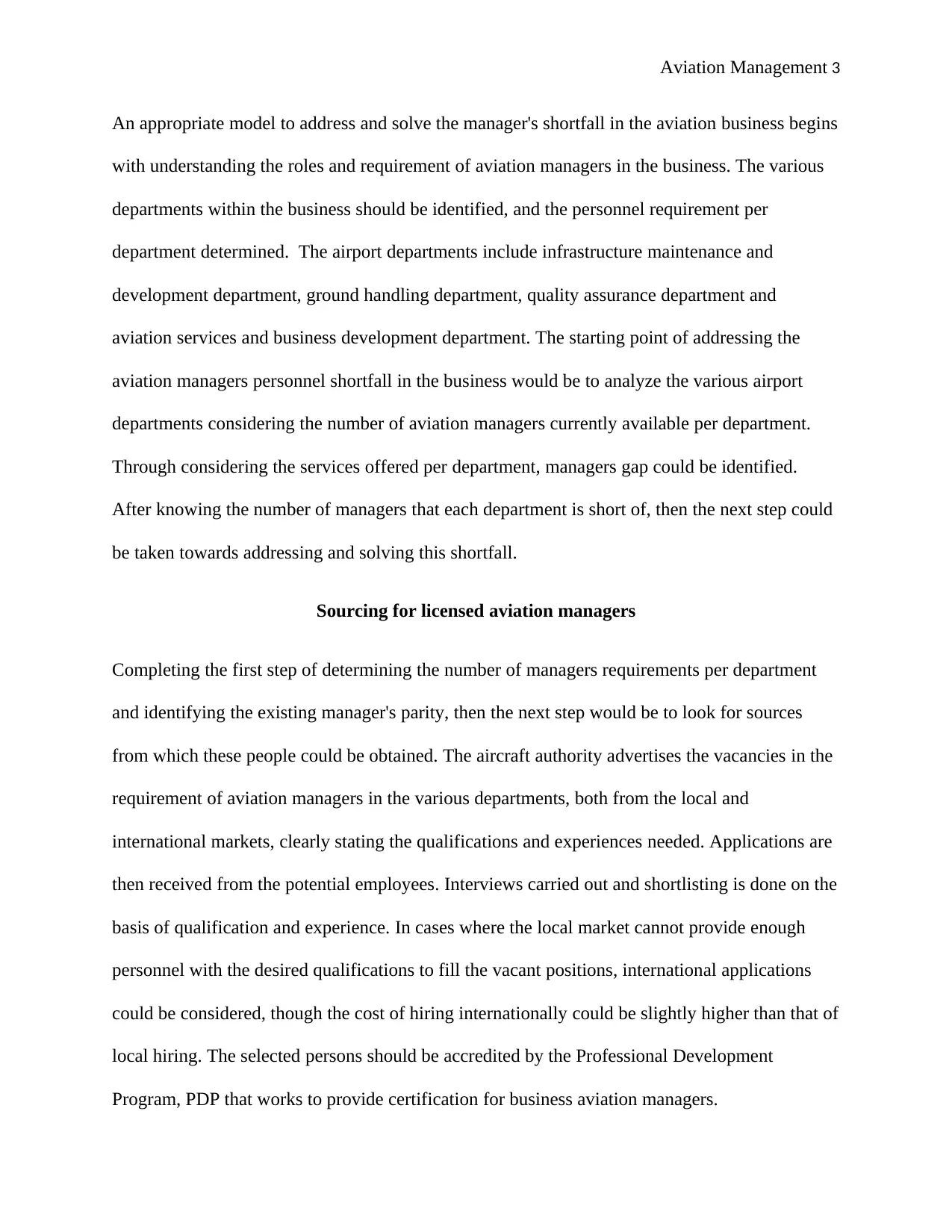
Aviation Management 3
An appropriate model to address and solve the manager's shortfall in the aviation business begins
with understanding the roles and requirement of aviation managers in the business. The various
departments within the business should be identified, and the personnel requirement per
department determined. The airport departments include infrastructure maintenance and
development department, ground handling department, quality assurance department and
aviation services and business development department. The starting point of addressing the
aviation managers personnel shortfall in the business would be to analyze the various airport
departments considering the number of aviation managers currently available per department.
Through considering the services offered per department, managers gap could be identified.
After knowing the number of managers that each department is short of, then the next step could
be taken towards addressing and solving this shortfall.
Sourcing for licensed aviation managers
Completing the first step of determining the number of managers requirements per department
and identifying the existing manager's parity, then the next step would be to look for sources
from which these people could be obtained. The aircraft authority advertises the vacancies in the
requirement of aviation managers in the various departments, both from the local and
international markets, clearly stating the qualifications and experiences needed. Applications are
then received from the potential employees. Interviews carried out and shortlisting is done on the
basis of qualification and experience. In cases where the local market cannot provide enough
personnel with the desired qualifications to fill the vacant positions, international applications
could be considered, though the cost of hiring internationally could be slightly higher than that of
local hiring. The selected persons should be accredited by the Professional Development
Program, PDP that works to provide certification for business aviation managers.
An appropriate model to address and solve the manager's shortfall in the aviation business begins
with understanding the roles and requirement of aviation managers in the business. The various
departments within the business should be identified, and the personnel requirement per
department determined. The airport departments include infrastructure maintenance and
development department, ground handling department, quality assurance department and
aviation services and business development department. The starting point of addressing the
aviation managers personnel shortfall in the business would be to analyze the various airport
departments considering the number of aviation managers currently available per department.
Through considering the services offered per department, managers gap could be identified.
After knowing the number of managers that each department is short of, then the next step could
be taken towards addressing and solving this shortfall.
Sourcing for licensed aviation managers
Completing the first step of determining the number of managers requirements per department
and identifying the existing manager's parity, then the next step would be to look for sources
from which these people could be obtained. The aircraft authority advertises the vacancies in the
requirement of aviation managers in the various departments, both from the local and
international markets, clearly stating the qualifications and experiences needed. Applications are
then received from the potential employees. Interviews carried out and shortlisting is done on the
basis of qualification and experience. In cases where the local market cannot provide enough
personnel with the desired qualifications to fill the vacant positions, international applications
could be considered, though the cost of hiring internationally could be slightly higher than that of
local hiring. The selected persons should be accredited by the Professional Development
Program, PDP that works to provide certification for business aviation managers.
⊘ This is a preview!⊘
Do you want full access?
Subscribe today to unlock all pages.

Trusted by 1+ million students worldwide
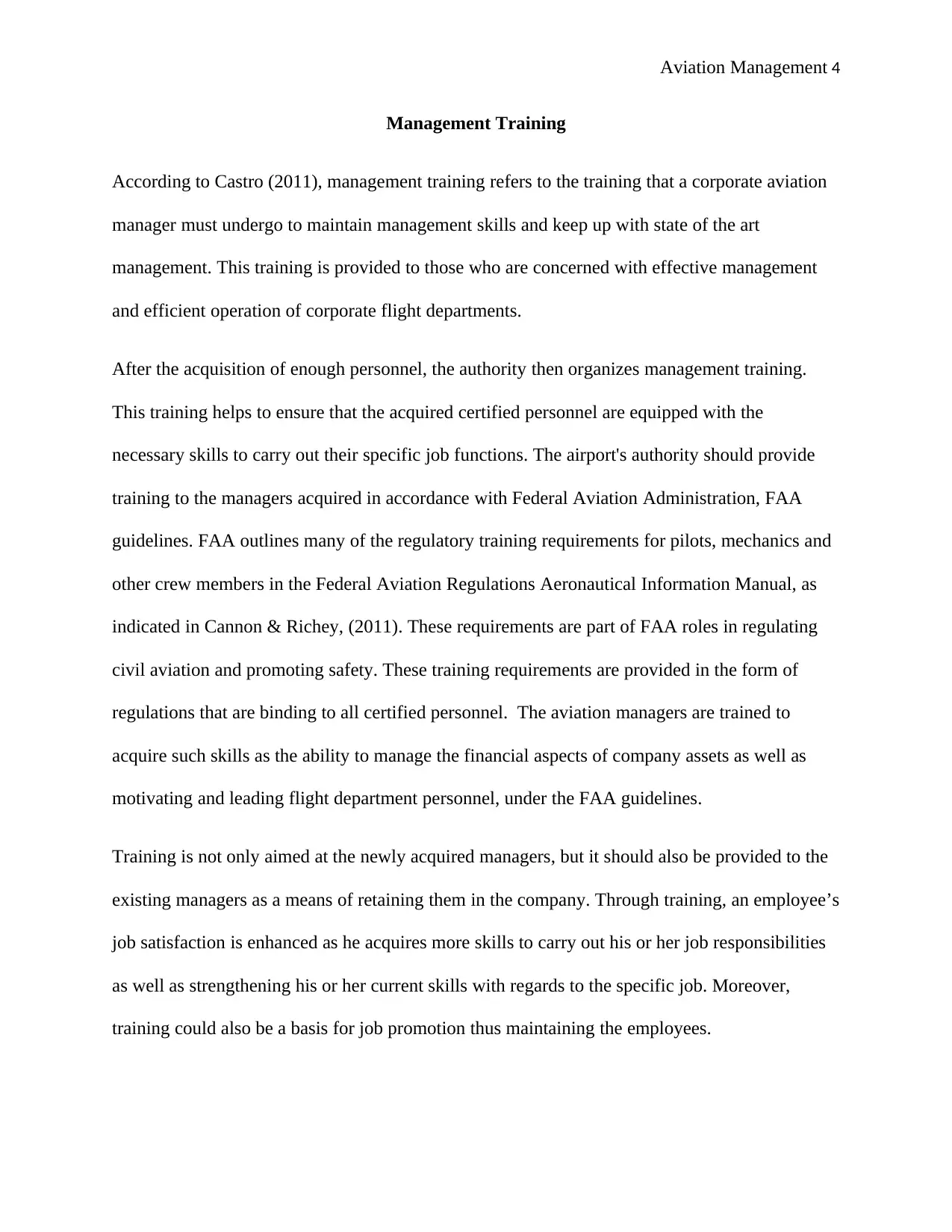
Aviation Management 4
Management Training
According to Castro (2011), management training refers to the training that a corporate aviation
manager must undergo to maintain management skills and keep up with state of the art
management. This training is provided to those who are concerned with effective management
and efficient operation of corporate flight departments.
After the acquisition of enough personnel, the authority then organizes management training.
This training helps to ensure that the acquired certified personnel are equipped with the
necessary skills to carry out their specific job functions. The airport's authority should provide
training to the managers acquired in accordance with Federal Aviation Administration, FAA
guidelines. FAA outlines many of the regulatory training requirements for pilots, mechanics and
other crew members in the Federal Aviation Regulations Aeronautical Information Manual, as
indicated in Cannon & Richey, (2011). These requirements are part of FAA roles in regulating
civil aviation and promoting safety. These training requirements are provided in the form of
regulations that are binding to all certified personnel. The aviation managers are trained to
acquire such skills as the ability to manage the financial aspects of company assets as well as
motivating and leading flight department personnel, under the FAA guidelines.
Training is not only aimed at the newly acquired managers, but it should also be provided to the
existing managers as a means of retaining them in the company. Through training, an employee’s
job satisfaction is enhanced as he acquires more skills to carry out his or her job responsibilities
as well as strengthening his or her current skills with regards to the specific job. Moreover,
training could also be a basis for job promotion thus maintaining the employees.
Management Training
According to Castro (2011), management training refers to the training that a corporate aviation
manager must undergo to maintain management skills and keep up with state of the art
management. This training is provided to those who are concerned with effective management
and efficient operation of corporate flight departments.
After the acquisition of enough personnel, the authority then organizes management training.
This training helps to ensure that the acquired certified personnel are equipped with the
necessary skills to carry out their specific job functions. The airport's authority should provide
training to the managers acquired in accordance with Federal Aviation Administration, FAA
guidelines. FAA outlines many of the regulatory training requirements for pilots, mechanics and
other crew members in the Federal Aviation Regulations Aeronautical Information Manual, as
indicated in Cannon & Richey, (2011). These requirements are part of FAA roles in regulating
civil aviation and promoting safety. These training requirements are provided in the form of
regulations that are binding to all certified personnel. The aviation managers are trained to
acquire such skills as the ability to manage the financial aspects of company assets as well as
motivating and leading flight department personnel, under the FAA guidelines.
Training is not only aimed at the newly acquired managers, but it should also be provided to the
existing managers as a means of retaining them in the company. Through training, an employee’s
job satisfaction is enhanced as he acquires more skills to carry out his or her job responsibilities
as well as strengthening his or her current skills with regards to the specific job. Moreover,
training could also be a basis for job promotion thus maintaining the employees.
Paraphrase This Document
Need a fresh take? Get an instant paraphrase of this document with our AI Paraphraser
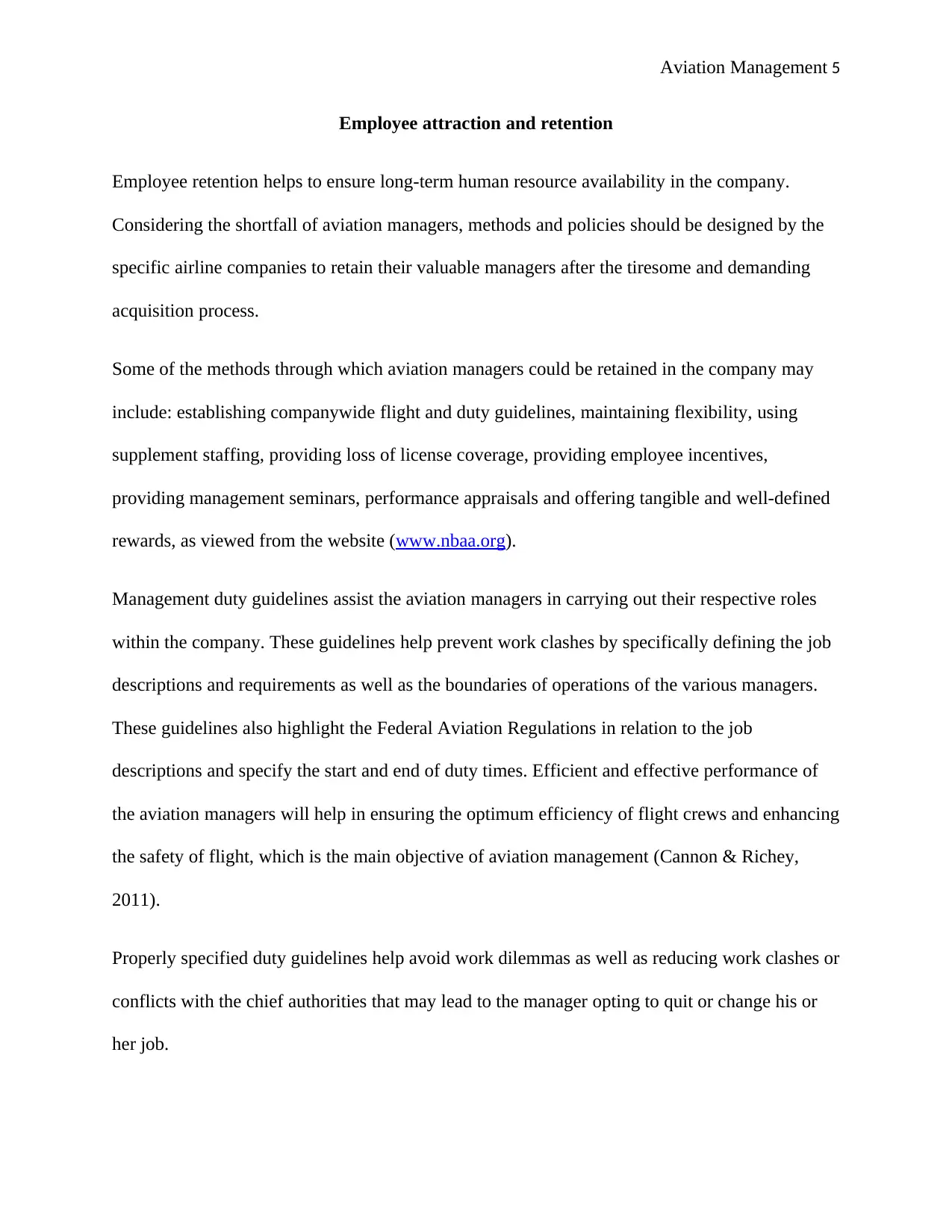
Aviation Management 5
Employee attraction and retention
Employee retention helps to ensure long-term human resource availability in the company.
Considering the shortfall of aviation managers, methods and policies should be designed by the
specific airline companies to retain their valuable managers after the tiresome and demanding
acquisition process.
Some of the methods through which aviation managers could be retained in the company may
include: establishing companywide flight and duty guidelines, maintaining flexibility, using
supplement staffing, providing loss of license coverage, providing employee incentives,
providing management seminars, performance appraisals and offering tangible and well-defined
rewards, as viewed from the website (www.nbaa.org).
Management duty guidelines assist the aviation managers in carrying out their respective roles
within the company. These guidelines help prevent work clashes by specifically defining the job
descriptions and requirements as well as the boundaries of operations of the various managers.
These guidelines also highlight the Federal Aviation Regulations in relation to the job
descriptions and specify the start and end of duty times. Efficient and effective performance of
the aviation managers will help in ensuring the optimum efficiency of flight crews and enhancing
the safety of flight, which is the main objective of aviation management (Cannon & Richey,
2011).
Properly specified duty guidelines help avoid work dilemmas as well as reducing work clashes or
conflicts with the chief authorities that may lead to the manager opting to quit or change his or
her job.
Employee attraction and retention
Employee retention helps to ensure long-term human resource availability in the company.
Considering the shortfall of aviation managers, methods and policies should be designed by the
specific airline companies to retain their valuable managers after the tiresome and demanding
acquisition process.
Some of the methods through which aviation managers could be retained in the company may
include: establishing companywide flight and duty guidelines, maintaining flexibility, using
supplement staffing, providing loss of license coverage, providing employee incentives,
providing management seminars, performance appraisals and offering tangible and well-defined
rewards, as viewed from the website (www.nbaa.org).
Management duty guidelines assist the aviation managers in carrying out their respective roles
within the company. These guidelines help prevent work clashes by specifically defining the job
descriptions and requirements as well as the boundaries of operations of the various managers.
These guidelines also highlight the Federal Aviation Regulations in relation to the job
descriptions and specify the start and end of duty times. Efficient and effective performance of
the aviation managers will help in ensuring the optimum efficiency of flight crews and enhancing
the safety of flight, which is the main objective of aviation management (Cannon & Richey,
2011).
Properly specified duty guidelines help avoid work dilemmas as well as reducing work clashes or
conflicts with the chief authorities that may lead to the manager opting to quit or change his or
her job.
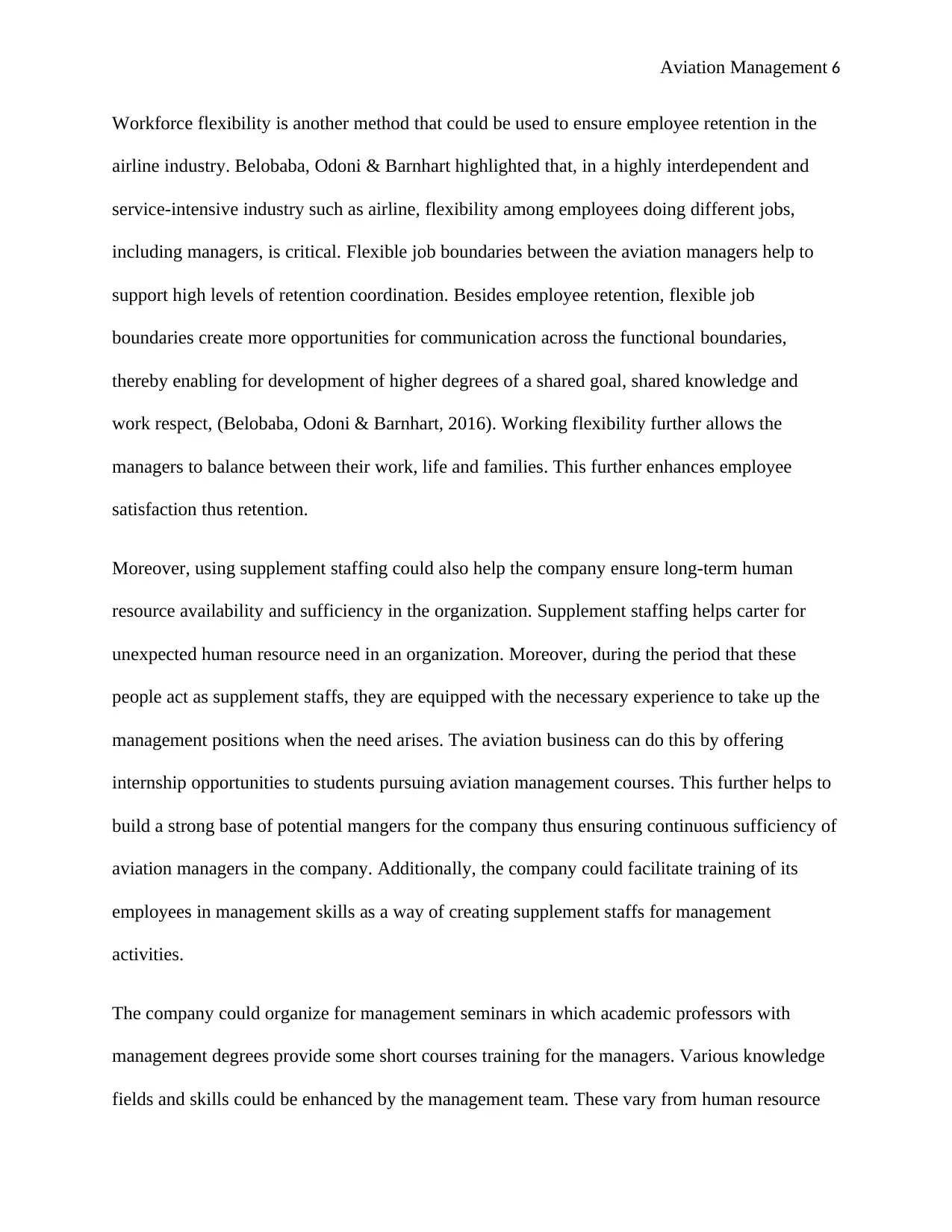
Aviation Management 6
Workforce flexibility is another method that could be used to ensure employee retention in the
airline industry. Belobaba, Odoni & Barnhart highlighted that, in a highly interdependent and
service-intensive industry such as airline, flexibility among employees doing different jobs,
including managers, is critical. Flexible job boundaries between the aviation managers help to
support high levels of retention coordination. Besides employee retention, flexible job
boundaries create more opportunities for communication across the functional boundaries,
thereby enabling for development of higher degrees of a shared goal, shared knowledge and
work respect, (Belobaba, Odoni & Barnhart, 2016). Working flexibility further allows the
managers to balance between their work, life and families. This further enhances employee
satisfaction thus retention.
Moreover, using supplement staffing could also help the company ensure long-term human
resource availability and sufficiency in the organization. Supplement staffing helps carter for
unexpected human resource need in an organization. Moreover, during the period that these
people act as supplement staffs, they are equipped with the necessary experience to take up the
management positions when the need arises. The aviation business can do this by offering
internship opportunities to students pursuing aviation management courses. This further helps to
build a strong base of potential mangers for the company thus ensuring continuous sufficiency of
aviation managers in the company. Additionally, the company could facilitate training of its
employees in management skills as a way of creating supplement staffs for management
activities.
The company could organize for management seminars in which academic professors with
management degrees provide some short courses training for the managers. Various knowledge
fields and skills could be enhanced by the management team. These vary from human resource
Workforce flexibility is another method that could be used to ensure employee retention in the
airline industry. Belobaba, Odoni & Barnhart highlighted that, in a highly interdependent and
service-intensive industry such as airline, flexibility among employees doing different jobs,
including managers, is critical. Flexible job boundaries between the aviation managers help to
support high levels of retention coordination. Besides employee retention, flexible job
boundaries create more opportunities for communication across the functional boundaries,
thereby enabling for development of higher degrees of a shared goal, shared knowledge and
work respect, (Belobaba, Odoni & Barnhart, 2016). Working flexibility further allows the
managers to balance between their work, life and families. This further enhances employee
satisfaction thus retention.
Moreover, using supplement staffing could also help the company ensure long-term human
resource availability and sufficiency in the organization. Supplement staffing helps carter for
unexpected human resource need in an organization. Moreover, during the period that these
people act as supplement staffs, they are equipped with the necessary experience to take up the
management positions when the need arises. The aviation business can do this by offering
internship opportunities to students pursuing aviation management courses. This further helps to
build a strong base of potential mangers for the company thus ensuring continuous sufficiency of
aviation managers in the company. Additionally, the company could facilitate training of its
employees in management skills as a way of creating supplement staffs for management
activities.
The company could organize for management seminars in which academic professors with
management degrees provide some short courses training for the managers. Various knowledge
fields and skills could be enhanced by the management team. These vary from human resource
⊘ This is a preview!⊘
Do you want full access?
Subscribe today to unlock all pages.

Trusted by 1+ million students worldwide
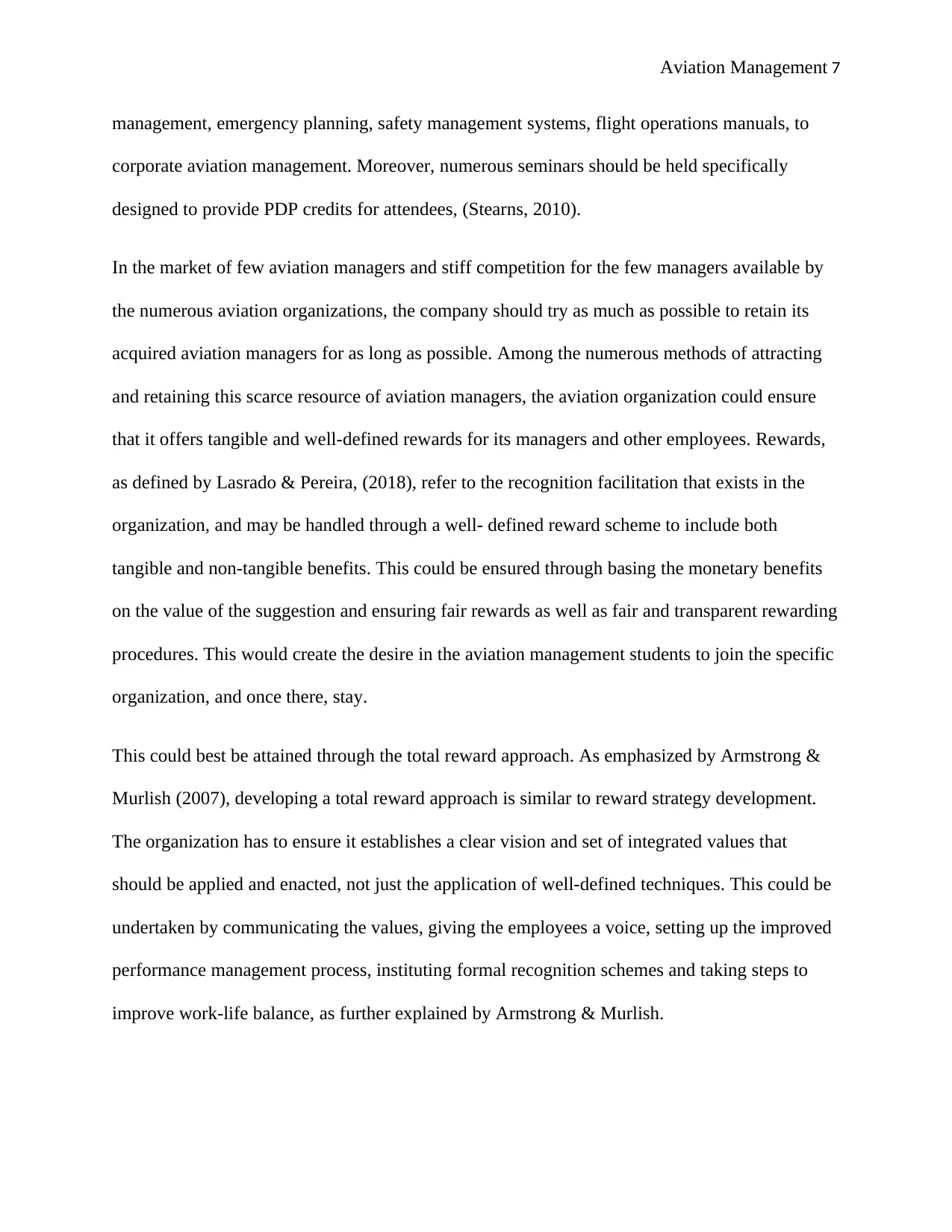
Aviation Management 7
management, emergency planning, safety management systems, flight operations manuals, to
corporate aviation management. Moreover, numerous seminars should be held specifically
designed to provide PDP credits for attendees, (Stearns, 2010).
In the market of few aviation managers and stiff competition for the few managers available by
the numerous aviation organizations, the company should try as much as possible to retain its
acquired aviation managers for as long as possible. Among the numerous methods of attracting
and retaining this scarce resource of aviation managers, the aviation organization could ensure
that it offers tangible and well-defined rewards for its managers and other employees. Rewards,
as defined by Lasrado & Pereira, (2018), refer to the recognition facilitation that exists in the
organization, and may be handled through a well- defined reward scheme to include both
tangible and non-tangible benefits. This could be ensured through basing the monetary benefits
on the value of the suggestion and ensuring fair rewards as well as fair and transparent rewarding
procedures. This would create the desire in the aviation management students to join the specific
organization, and once there, stay.
This could best be attained through the total reward approach. As emphasized by Armstrong &
Murlish (2007), developing a total reward approach is similar to reward strategy development.
The organization has to ensure it establishes a clear vision and set of integrated values that
should be applied and enacted, not just the application of well-defined techniques. This could be
undertaken by communicating the values, giving the employees a voice, setting up the improved
performance management process, instituting formal recognition schemes and taking steps to
improve work-life balance, as further explained by Armstrong & Murlish.
management, emergency planning, safety management systems, flight operations manuals, to
corporate aviation management. Moreover, numerous seminars should be held specifically
designed to provide PDP credits for attendees, (Stearns, 2010).
In the market of few aviation managers and stiff competition for the few managers available by
the numerous aviation organizations, the company should try as much as possible to retain its
acquired aviation managers for as long as possible. Among the numerous methods of attracting
and retaining this scarce resource of aviation managers, the aviation organization could ensure
that it offers tangible and well-defined rewards for its managers and other employees. Rewards,
as defined by Lasrado & Pereira, (2018), refer to the recognition facilitation that exists in the
organization, and may be handled through a well- defined reward scheme to include both
tangible and non-tangible benefits. This could be ensured through basing the monetary benefits
on the value of the suggestion and ensuring fair rewards as well as fair and transparent rewarding
procedures. This would create the desire in the aviation management students to join the specific
organization, and once there, stay.
This could best be attained through the total reward approach. As emphasized by Armstrong &
Murlish (2007), developing a total reward approach is similar to reward strategy development.
The organization has to ensure it establishes a clear vision and set of integrated values that
should be applied and enacted, not just the application of well-defined techniques. This could be
undertaken by communicating the values, giving the employees a voice, setting up the improved
performance management process, instituting formal recognition schemes and taking steps to
improve work-life balance, as further explained by Armstrong & Murlish.
Paraphrase This Document
Need a fresh take? Get an instant paraphrase of this document with our AI Paraphraser
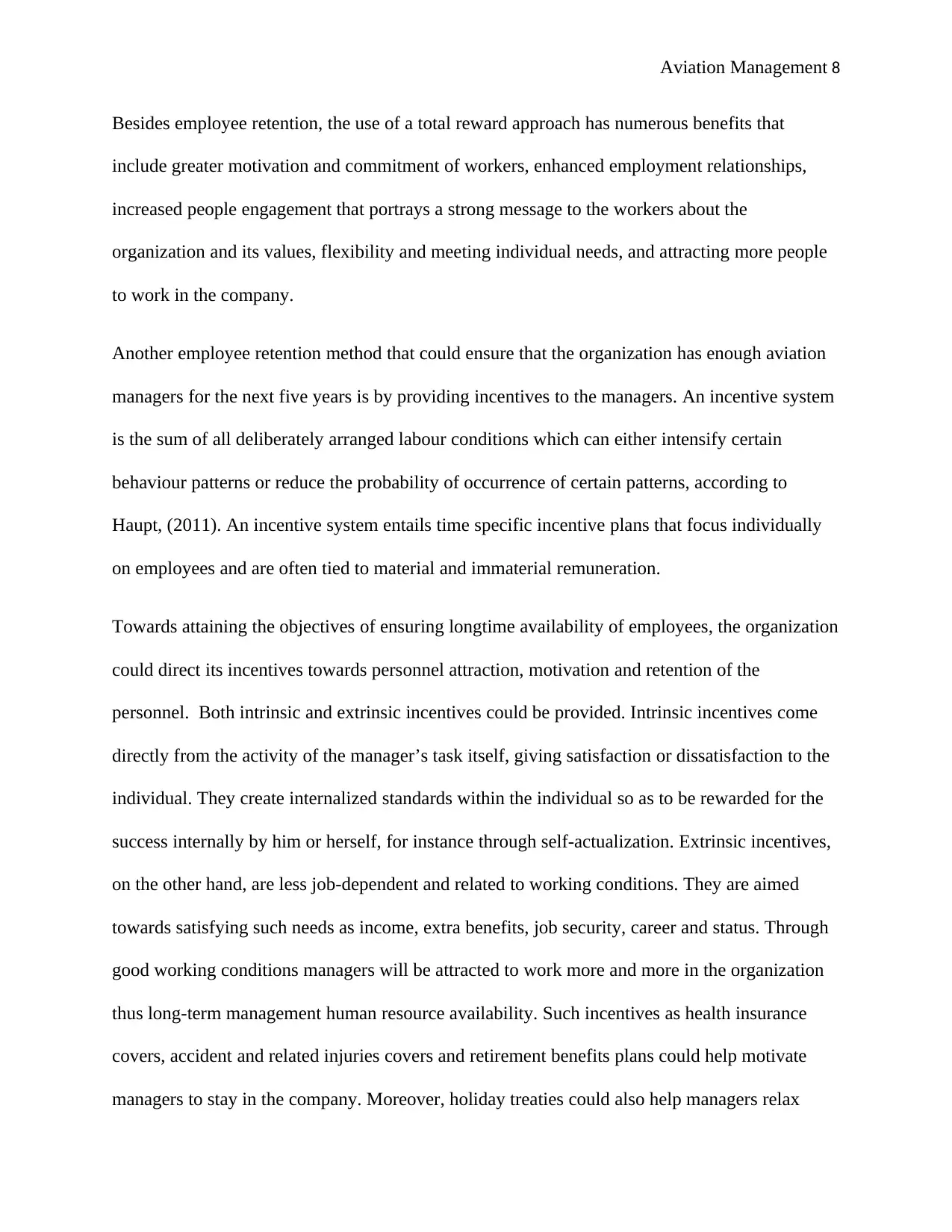
Aviation Management 8
Besides employee retention, the use of a total reward approach has numerous benefits that
include greater motivation and commitment of workers, enhanced employment relationships,
increased people engagement that portrays a strong message to the workers about the
organization and its values, flexibility and meeting individual needs, and attracting more people
to work in the company.
Another employee retention method that could ensure that the organization has enough aviation
managers for the next five years is by providing incentives to the managers. An incentive system
is the sum of all deliberately arranged labour conditions which can either intensify certain
behaviour patterns or reduce the probability of occurrence of certain patterns, according to
Haupt, (2011). An incentive system entails time specific incentive plans that focus individually
on employees and are often tied to material and immaterial remuneration.
Towards attaining the objectives of ensuring longtime availability of employees, the organization
could direct its incentives towards personnel attraction, motivation and retention of the
personnel. Both intrinsic and extrinsic incentives could be provided. Intrinsic incentives come
directly from the activity of the manager’s task itself, giving satisfaction or dissatisfaction to the
individual. They create internalized standards within the individual so as to be rewarded for the
success internally by him or herself, for instance through self-actualization. Extrinsic incentives,
on the other hand, are less job-dependent and related to working conditions. They are aimed
towards satisfying such needs as income, extra benefits, job security, career and status. Through
good working conditions managers will be attracted to work more and more in the organization
thus long-term management human resource availability. Such incentives as health insurance
covers, accident and related injuries covers and retirement benefits plans could help motivate
managers to stay in the company. Moreover, holiday treaties could also help managers relax
Besides employee retention, the use of a total reward approach has numerous benefits that
include greater motivation and commitment of workers, enhanced employment relationships,
increased people engagement that portrays a strong message to the workers about the
organization and its values, flexibility and meeting individual needs, and attracting more people
to work in the company.
Another employee retention method that could ensure that the organization has enough aviation
managers for the next five years is by providing incentives to the managers. An incentive system
is the sum of all deliberately arranged labour conditions which can either intensify certain
behaviour patterns or reduce the probability of occurrence of certain patterns, according to
Haupt, (2011). An incentive system entails time specific incentive plans that focus individually
on employees and are often tied to material and immaterial remuneration.
Towards attaining the objectives of ensuring longtime availability of employees, the organization
could direct its incentives towards personnel attraction, motivation and retention of the
personnel. Both intrinsic and extrinsic incentives could be provided. Intrinsic incentives come
directly from the activity of the manager’s task itself, giving satisfaction or dissatisfaction to the
individual. They create internalized standards within the individual so as to be rewarded for the
success internally by him or herself, for instance through self-actualization. Extrinsic incentives,
on the other hand, are less job-dependent and related to working conditions. They are aimed
towards satisfying such needs as income, extra benefits, job security, career and status. Through
good working conditions managers will be attracted to work more and more in the organization
thus long-term management human resource availability. Such incentives as health insurance
covers, accident and related injuries covers and retirement benefits plans could help motivate
managers to stay in the company. Moreover, holiday treaties could also help managers relax
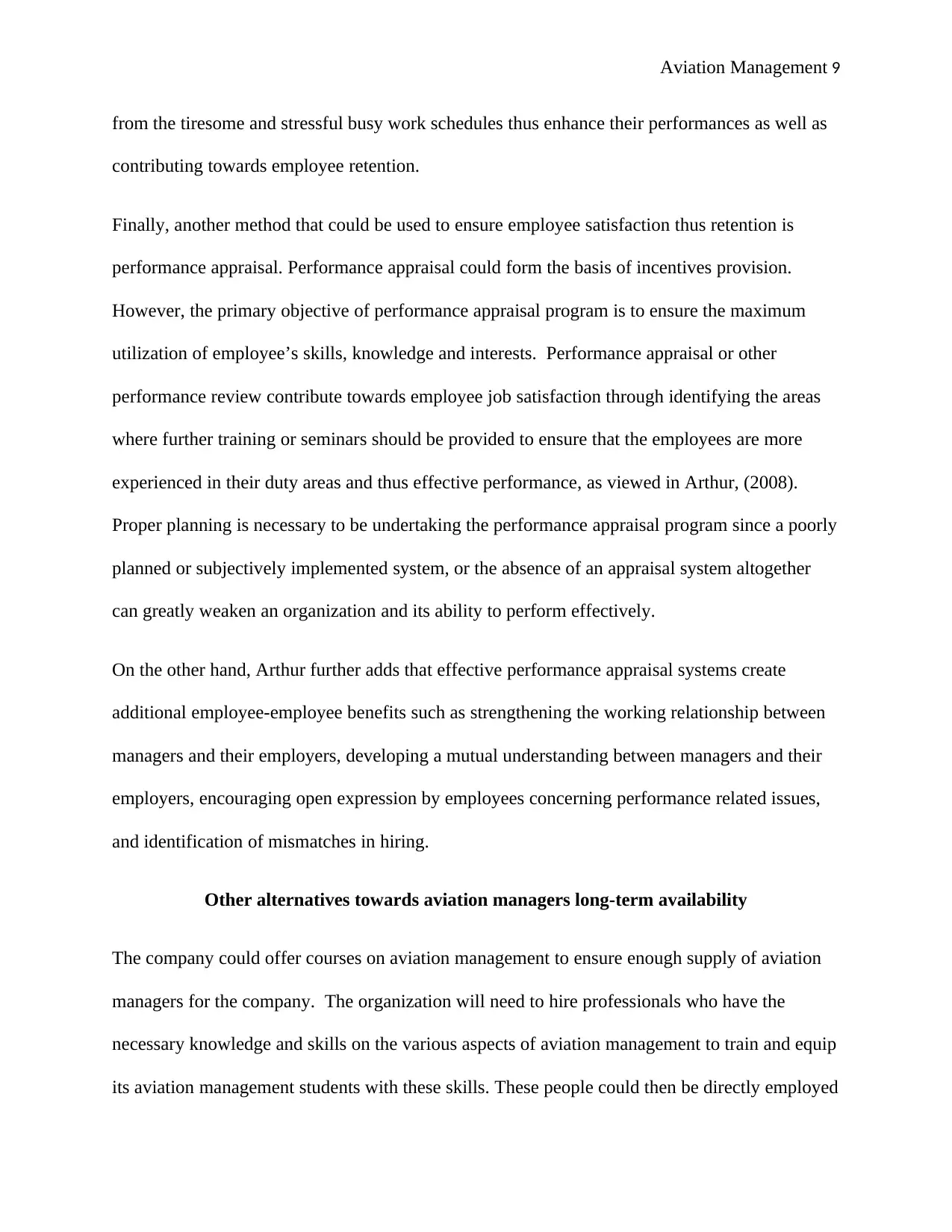
Aviation Management 9
from the tiresome and stressful busy work schedules thus enhance their performances as well as
contributing towards employee retention.
Finally, another method that could be used to ensure employee satisfaction thus retention is
performance appraisal. Performance appraisal could form the basis of incentives provision.
However, the primary objective of performance appraisal program is to ensure the maximum
utilization of employee’s skills, knowledge and interests. Performance appraisal or other
performance review contribute towards employee job satisfaction through identifying the areas
where further training or seminars should be provided to ensure that the employees are more
experienced in their duty areas and thus effective performance, as viewed in Arthur, (2008).
Proper planning is necessary to be undertaking the performance appraisal program since a poorly
planned or subjectively implemented system, or the absence of an appraisal system altogether
can greatly weaken an organization and its ability to perform effectively.
On the other hand, Arthur further adds that effective performance appraisal systems create
additional employee-employee benefits such as strengthening the working relationship between
managers and their employers, developing a mutual understanding between managers and their
employers, encouraging open expression by employees concerning performance related issues,
and identification of mismatches in hiring.
Other alternatives towards aviation managers long-term availability
The company could offer courses on aviation management to ensure enough supply of aviation
managers for the company. The organization will need to hire professionals who have the
necessary knowledge and skills on the various aspects of aviation management to train and equip
its aviation management students with these skills. These people could then be directly employed
from the tiresome and stressful busy work schedules thus enhance their performances as well as
contributing towards employee retention.
Finally, another method that could be used to ensure employee satisfaction thus retention is
performance appraisal. Performance appraisal could form the basis of incentives provision.
However, the primary objective of performance appraisal program is to ensure the maximum
utilization of employee’s skills, knowledge and interests. Performance appraisal or other
performance review contribute towards employee job satisfaction through identifying the areas
where further training or seminars should be provided to ensure that the employees are more
experienced in their duty areas and thus effective performance, as viewed in Arthur, (2008).
Proper planning is necessary to be undertaking the performance appraisal program since a poorly
planned or subjectively implemented system, or the absence of an appraisal system altogether
can greatly weaken an organization and its ability to perform effectively.
On the other hand, Arthur further adds that effective performance appraisal systems create
additional employee-employee benefits such as strengthening the working relationship between
managers and their employers, developing a mutual understanding between managers and their
employers, encouraging open expression by employees concerning performance related issues,
and identification of mismatches in hiring.
Other alternatives towards aviation managers long-term availability
The company could offer courses on aviation management to ensure enough supply of aviation
managers for the company. The organization will need to hire professionals who have the
necessary knowledge and skills on the various aspects of aviation management to train and equip
its aviation management students with these skills. These people could then be directly employed
⊘ This is a preview!⊘
Do you want full access?
Subscribe today to unlock all pages.

Trusted by 1+ million students worldwide
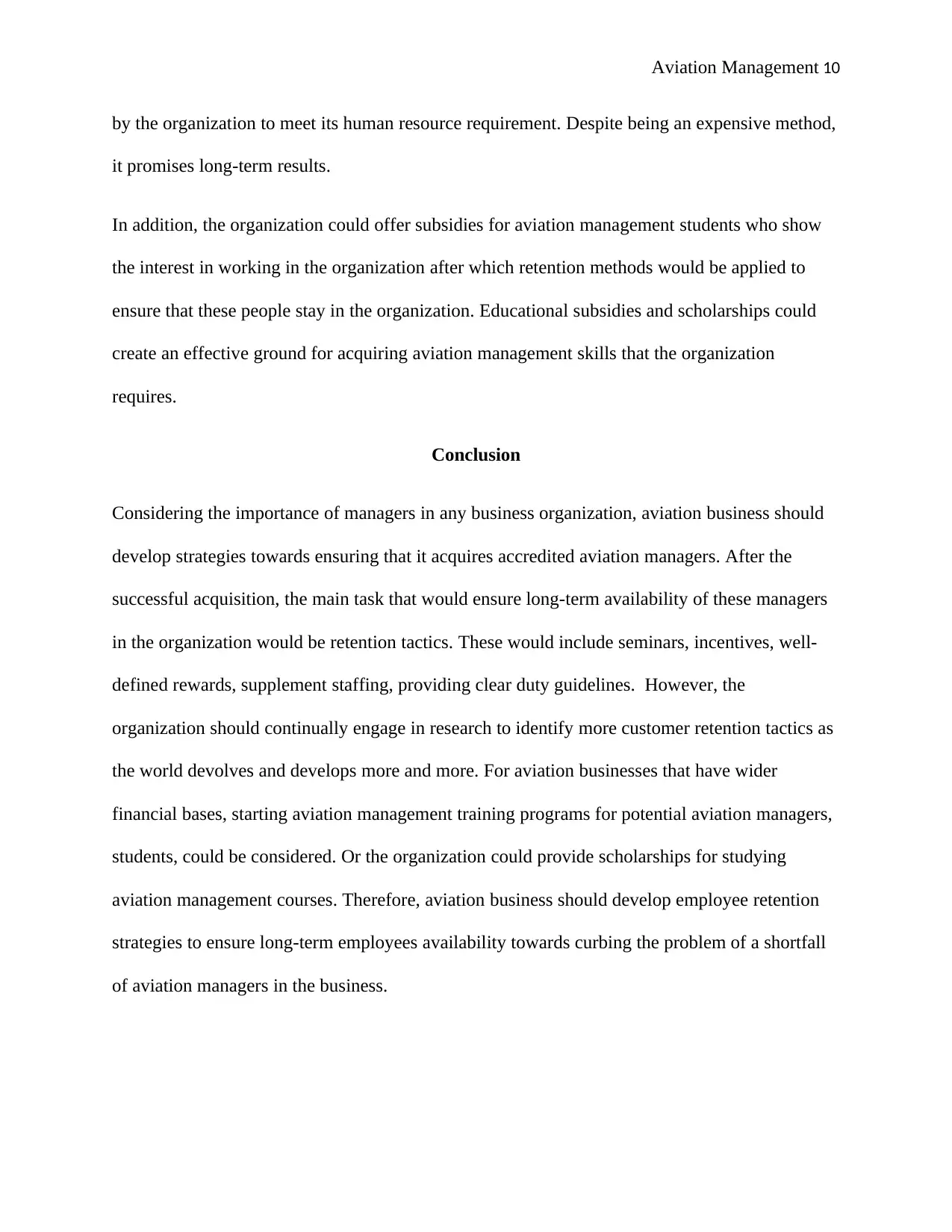
Aviation Management 10
by the organization to meet its human resource requirement. Despite being an expensive method,
it promises long-term results.
In addition, the organization could offer subsidies for aviation management students who show
the interest in working in the organization after which retention methods would be applied to
ensure that these people stay in the organization. Educational subsidies and scholarships could
create an effective ground for acquiring aviation management skills that the organization
requires.
Conclusion
Considering the importance of managers in any business organization, aviation business should
develop strategies towards ensuring that it acquires accredited aviation managers. After the
successful acquisition, the main task that would ensure long-term availability of these managers
in the organization would be retention tactics. These would include seminars, incentives, well-
defined rewards, supplement staffing, providing clear duty guidelines. However, the
organization should continually engage in research to identify more customer retention tactics as
the world devolves and develops more and more. For aviation businesses that have wider
financial bases, starting aviation management training programs for potential aviation managers,
students, could be considered. Or the organization could provide scholarships for studying
aviation management courses. Therefore, aviation business should develop employee retention
strategies to ensure long-term employees availability towards curbing the problem of a shortfall
of aviation managers in the business.
by the organization to meet its human resource requirement. Despite being an expensive method,
it promises long-term results.
In addition, the organization could offer subsidies for aviation management students who show
the interest in working in the organization after which retention methods would be applied to
ensure that these people stay in the organization. Educational subsidies and scholarships could
create an effective ground for acquiring aviation management skills that the organization
requires.
Conclusion
Considering the importance of managers in any business organization, aviation business should
develop strategies towards ensuring that it acquires accredited aviation managers. After the
successful acquisition, the main task that would ensure long-term availability of these managers
in the organization would be retention tactics. These would include seminars, incentives, well-
defined rewards, supplement staffing, providing clear duty guidelines. However, the
organization should continually engage in research to identify more customer retention tactics as
the world devolves and develops more and more. For aviation businesses that have wider
financial bases, starting aviation management training programs for potential aviation managers,
students, could be considered. Or the organization could provide scholarships for studying
aviation management courses. Therefore, aviation business should develop employee retention
strategies to ensure long-term employees availability towards curbing the problem of a shortfall
of aviation managers in the business.
Paraphrase This Document
Need a fresh take? Get an instant paraphrase of this document with our AI Paraphraser
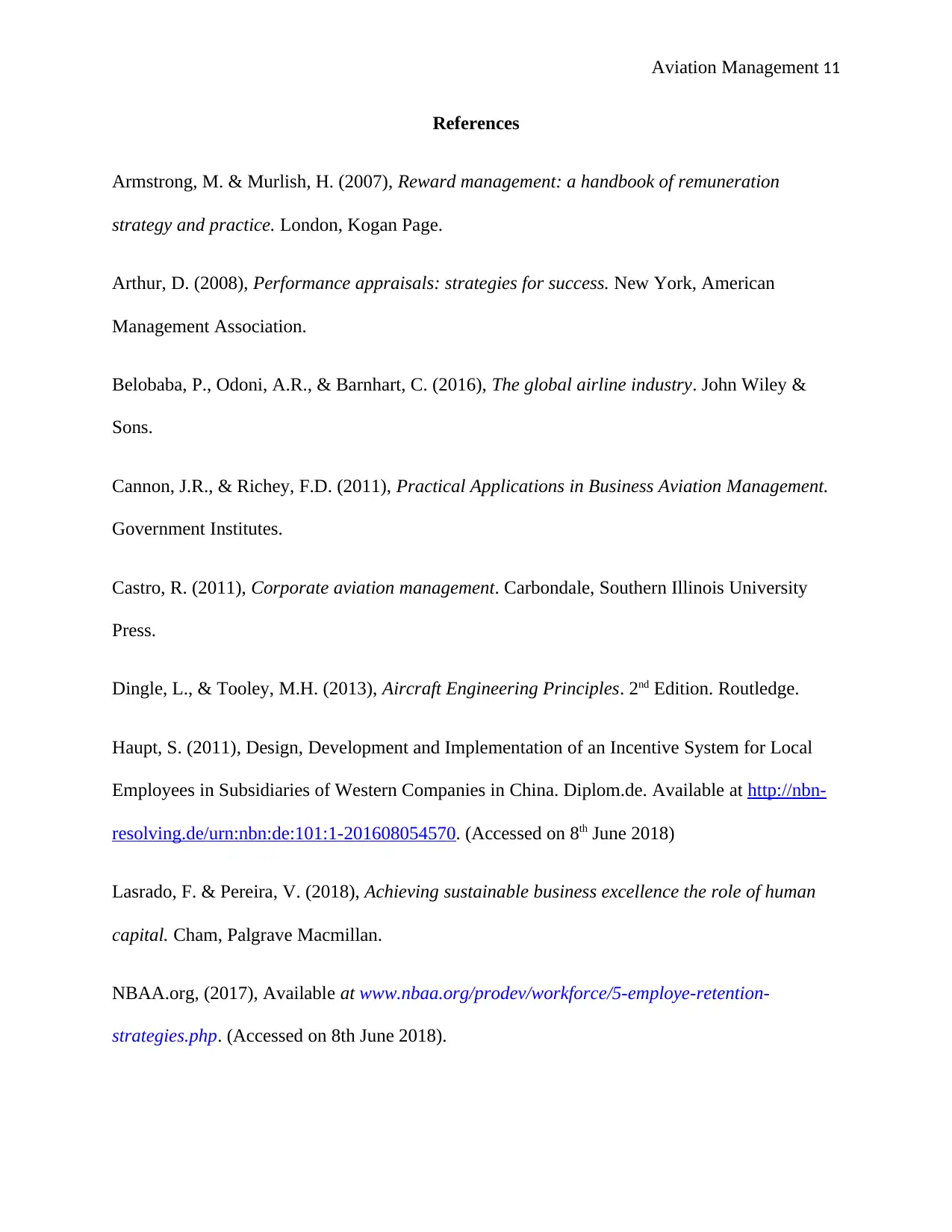
Aviation Management 11
References
Armstrong, M. & Murlish, H. (2007), Reward management: a handbook of remuneration
strategy and practice. London, Kogan Page.
Arthur, D. (2008), Performance appraisals: strategies for success. New York, American
Management Association.
Belobaba, P., Odoni, A.R., & Barnhart, C. (2016), The global airline industry. John Wiley &
Sons.
Cannon, J.R., & Richey, F.D. (2011), Practical Applications in Business Aviation Management.
Government Institutes.
Castro, R. (2011), Corporate aviation management. Carbondale, Southern Illinois University
Press.
Dingle, L., & Tooley, M.H. (2013), Aircraft Engineering Principles. 2nd Edition. Routledge.
Haupt, S. (2011), Design, Development and Implementation of an Incentive System for Local
Employees in Subsidiaries of Western Companies in China. Diplom.de. Available at http://nbn-
resolving.de/urn:nbn:de:101:1-201608054570. (Accessed on 8th June 2018)
Lasrado, F. & Pereira, V. (2018), Achieving sustainable business excellence the role of human
capital. Cham, Palgrave Macmillan.
NBAA.org, (2017), Available at www.nbaa.org/prodev/workforce/5-employe-retention-
strategies.php. (Accessed on 8th June 2018).
References
Armstrong, M. & Murlish, H. (2007), Reward management: a handbook of remuneration
strategy and practice. London, Kogan Page.
Arthur, D. (2008), Performance appraisals: strategies for success. New York, American
Management Association.
Belobaba, P., Odoni, A.R., & Barnhart, C. (2016), The global airline industry. John Wiley &
Sons.
Cannon, J.R., & Richey, F.D. (2011), Practical Applications in Business Aviation Management.
Government Institutes.
Castro, R. (2011), Corporate aviation management. Carbondale, Southern Illinois University
Press.
Dingle, L., & Tooley, M.H. (2013), Aircraft Engineering Principles. 2nd Edition. Routledge.
Haupt, S. (2011), Design, Development and Implementation of an Incentive System for Local
Employees in Subsidiaries of Western Companies in China. Diplom.de. Available at http://nbn-
resolving.de/urn:nbn:de:101:1-201608054570. (Accessed on 8th June 2018)
Lasrado, F. & Pereira, V. (2018), Achieving sustainable business excellence the role of human
capital. Cham, Palgrave Macmillan.
NBAA.org, (2017), Available at www.nbaa.org/prodev/workforce/5-employe-retention-
strategies.php. (Accessed on 8th June 2018).
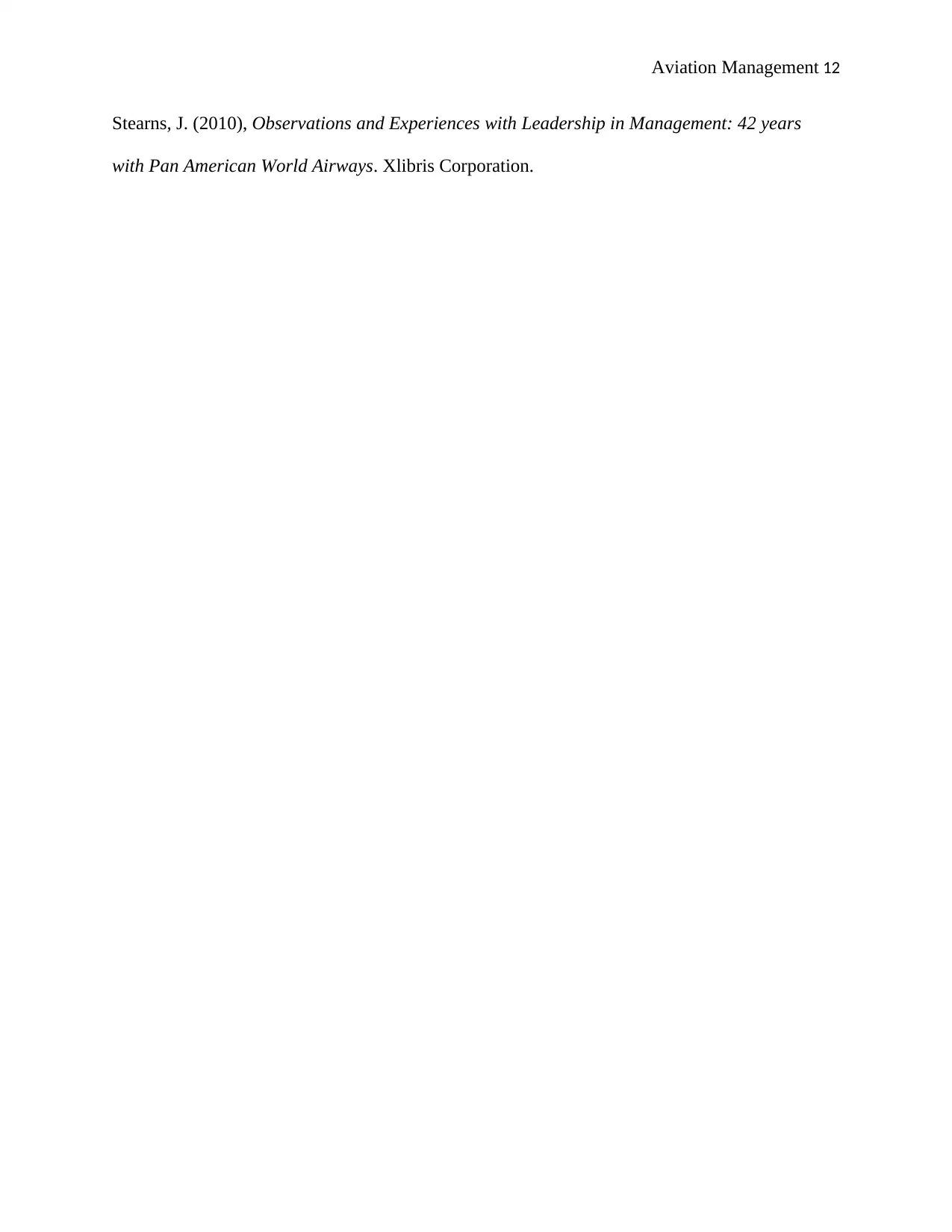
Aviation Management 12
Stearns, J. (2010), Observations and Experiences with Leadership in Management: 42 years
with Pan American World Airways. Xlibris Corporation.
Stearns, J. (2010), Observations and Experiences with Leadership in Management: 42 years
with Pan American World Airways. Xlibris Corporation.
⊘ This is a preview!⊘
Do you want full access?
Subscribe today to unlock all pages.

Trusted by 1+ million students worldwide
1 out of 12
Your All-in-One AI-Powered Toolkit for Academic Success.
+13062052269
info@desklib.com
Available 24*7 on WhatsApp / Email
![[object Object]](/_next/static/media/star-bottom.7253800d.svg)
Unlock your academic potential
Copyright © 2020–2025 A2Z Services. All Rights Reserved. Developed and managed by ZUCOL.